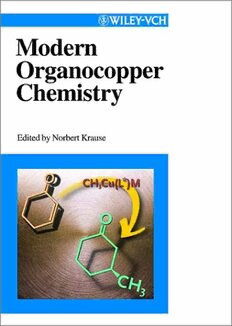
Modern arene chemistry PDF
Preview Modern arene chemistry
EditedbyDidierAstruc ModernAreneChemistry ModernAreneChemistry. EditedbyDidierAstruc Copyright82002WILEY-VCHVerlagGmbH&Co.KGaA,Weinheim ISBN:3-527-30489-4 Related Titles from WILEY-VCH S.Kobayashi,K.A.Jørgensen(Eds.) Cycloaddition Reactions in Organic Synthesis XII,332pages 2001 Hardcover ISBN3-527-30159-3 N.Krause(Ed.) Modern Organocopper Chemistry XIV,373pages 2002 Hardcover ISBN3-527-29773-1 A.Ricci(Ed.) Modern Amination Methods XVIII,267pages 2000 Hardcover ISBN3-527-29976-9 F.Vo€gtle,J.F.Stoddart,M.Shibasaki(Eds.) Stimulating Concepts in Chemistry XVII,396pages 2000 Hardcover ISBN3-527-29978-5 Modern Arene Chemistry Edited by Didier Astruc Editor 9 Thisbookwascarefullyproduced.Nevertheless, editor,authorsandpublisherdonotwarrantthe Prof.DidierAstruc informationcontainedthereintobefreeoferrors. LCOO,UMRCNRSNo5802 Readersareadvisedtokeepinmindthatstatements, Universite´BordeauxI data,illustrations,proceduraldetailsorotheritems 33405TalenceCedex mayinadvertentlybeinaccurate. France LibraryofCongressCardNo.:appliedfor Acataloguerecordforthisbookisavailablefromthe BritishLibrary. DieDeutscheBibliothek–CIPCataloguing-in- Publication-Data Acataloguerecordforthispublicationisavailable fromDieDeutscheBibliothek (2002Wiley-VCHVerlagGmbH&KGaA, Weinheim Allrightsreserved(includingthoseoftranslation inotherlanguages).Nopartofthisbookmaybe reproducedinanyform–byphotoprinting, microfilm,oranyothermeans–nortransmittedor translatedintomachinelanguagewithoutwritten permissionfromthepublishers.Registerednames, trademarks,etc.usedinthisbook,evenwhennot specificallymarkedassuch,arenottobeconsidered unprotectedbylaw. PrintedintheFederalRepublicofGermany. Printedonacid-freepaper. Typesetting AscoTypesetters,HongKong Printing StraussOffsetdruckGmbH,Mo¨rlenbach Bookbinding J.Scha¨fferGmbH&Co.KG, Gru¨nstadt ISBN 3-527-30489-4 v Contents ListofContributors xvi AreneChemistry:FromHistoricalNotestotheStateoftheArt 1 DidierAstruc TheHistoryofBenzene 1 TheHistoryofAromaticity 5 SomeKeyTrendsTowardsModernAreneChemistry 9 AromaticChemistry:Fromthe19th CenturyIndustrytotheStateofthe Art 11 OrganizationoftheBookandContent 13 References 16 1 TheSynthesisofTris-AnnulatedBenzenesbyAldolTrimerizationofCyclic Ketones 20 MargaretM.BoorumandLawrenceT.Scott Abstract 20 1.1 Introduction 20 1.2 TruxeneandTruxone:VenerablePrototypes 21 1.3 OtherExamples 23 1.4 Limitations 27 1.4.1 ExperimentalObservationsandaWorkingHypothesis 27 1.4.2 GuidancefromCalculations 29 1.5 Conclusions 30 References 31 2 OligounsaturatedFive-MemberedCarbocycles – AromaticandAntiaromatic CompoundsintheSameFamily 32 RainerHaagandArmindeMeijere Abstract 32 2.1 Introduction 32 2.2 CyclopentadienylCations 33 2.3 FulveneandSpiroannelatedCyclopentadieneDerivatives 37 vi Contents 2.4 PolyunsaturatedDi-,Tri-,andOligoquinanes 38 2.4.1 Pentalene,Pentalenediide,andPentaleneMetalComplexes 39 2.4.2 Acepentalene,Acepentalenediide,andAcepentaleneMetalComplexes 42 2.4.3 GenerationofC20-Fullerene 44 References 50 3 TheSuzukiReactionwithArylboronCompoundsinAreneChemistry 53 AkiraSuzuki Abstract 53 3.1 Introduction 53 3.2 ReactionswithArylHalidesandTriflates:SynthesisofBiaryls 54 3.2.1 Aromatic–AromaticCoupling 54 3.2.2 Aromatic–HeteroaromaticandHeteroaromatic–HeteroaromaticCouplings 65 3.2.3 CouplingofArylboronCompoundsBearingStericallyBulkyorElectron- WithdrawingSubstituents 76 3.2.4 ModifiedCatalystsandLigands 80 3.2.5 Solid-PhaseSynthesis(CombinatorialMethodology) 84 3.3 Reactionswith1-AlkenylHalidesandTriflates 88 3.4 ReactionswithArylChloridesandOtherOrganicElectrophiles 93 3.5 Miscellaneous 98 3.6 ApplicationsinPolymerChemistry 99 References 102 4 Palladium-CatalyzedAminationofArylHalidesandSulfonates 107 JohnF.Hartwig Abstract 107 4.1 Introduction 107 4.1.1 SyntheticConsiderations 107 4.1.2 PriorCaXBond-FormingCouplingChemistryRelatedtotheAminationofAryl Halides 108 4.1.3 NovelOrganometallicChemistry 109 4.1.4 OrganizationoftheReview 109 4.2 Background 110 4.2.1 EarlyPalladium-CatalyzedAmination 110 4.2.2 InitialSyntheticProblemstobeSolved 111 4.3 Palladium-CatalyzedAminationofArylHalideswithAmine Substrates 111 4.3.1 EarlyWork 111 4.3.1.1 InitialIntermolecularTin-FreeAminationsofArylHalides 111 4.3.1.2 InitialIntramolecularAminationofArylHalides 112 4.3.2 SecondGenerationCatalysts:ArylBis-phosphines 112 4.3.2.1 AminationofArylHalides 112 4.3.2.2 AminationofArylTriflates 115 4.3.2.3 AminationofHeteroaromaticHalides 116 4.3.2.4 AminationsofSolid-SupportedArylHalides 119 Contents vii 4.3.2.5 AminationofPolyhalogenatedAromaticSubstrates 119 4.3.3 Third-GenerationCatalystswithAlkylmonophosphines 119 4.3.3.1 High-TemperatureAminationsInvolvingP(tBu)3 asLigand 120 4.3.3.2 UseofStericallyHinderedBis(phosphine)Ligands 120 4.3.3.3 P,NLigandsandDialkylphosphinobiarylLigands 121 4.3.3.4 PhenylBackbone-DerivedP,OLigands 123 4.3.3.5 Low-TemperatureReactionsEmployingP(tBu)3 asaLigand 124 4.3.3.6 HeterocyclicCarbenesasLigands 124 4.3.3.7 PhosphineOxideLigands 128 4.3.4 HeterogeneousCatalysts 129 4.4 AromaticCaNBondFormationwithNon-AmineSubstratesandAmmonia Surrogates 129 4.4.1 Amides,Sulfonamides,andCarbamates 130 4.4.2 AllylamineasanAmmoniaSurrogate 131 4.4.3 Imines 132 4.4.4 ProtectedHydrazines 132 4.4.5 Azoles 133 4.5 AminationofBase-SensitiveArylHalides 135 4.6 ApplicationsoftheAminationChemistry 136 4.6.1 SynthesisofBiologicallyActiveMolecules 136 4.6.1.1 ArylationofSecondaryAlkylamines 136 4.6.1.2 ArylationofPrimaryAlkylamines 138 4.6.2 ApplicationsinMaterialsScience 141 4.6.2.1 PolymerSynthesis 141 4.6.2.2 SynthesisofDiscreteOligomers 143 4.6.2.3 SynthesisofAzacyclophanes 146 4.6.2.4 SynthesisofSmallMoleculesforMaterialsApplications 146 4.6.3 Palladium-CatalyzedAminationinLigandSynthesis 147 4.7 MechanismofArylHalideAminationandEtheration 149 4.7.1 OxidativeAdditionofArylHalidestoL PdComplexes(L¼P(o-tolyl) ,BINAP, 2 3 DPPF)anditsMechanism 149 4.7.2 FormationofAmidoIntermediates 151 4.7.2.1 MechanismofPalladiumAmideFormationfromAmines 151 4.7.3 ReductiveEliminationsofAminesfromPd(II)AmidoComplexes 152 4.7.4 Competingb-HydrogenEliminationfromAmidoComplexes 155 4.7.5 Selectivity:ReductiveEliminationvs.b-HydrogenElimination 156 4.7.6 OverallCatalyticCyclewithSpecificIntermediates 158 4.7.6.1 MechanismforAminationCatalyzedbyP(o-C H Me) Palladium 6 4 3 Complexes 158 4.7.6.2 MechanismforAminationCatalyzedbyPalladiumComplexeswithChelating Ligands 159 4.7.6.3 MechanismofAminationCatalyzedbyPalladiumComplexeswithSterically HinderedAlkylMonophosphines 160 4.8 Summary 160 References 161 viii Contents 5 FromAcetylenestoAromatics:NovelRoutes –NovelProducts 169 HenningHopf Abstract 169 5.1 Introduction 169 5.2 TheAromatizationofHexa-1,3-dien-5-ynetoBenzene:Mechanismand PreparativeApplications 171 5.3 TheConstructionofExtendedAromaticSystemsfromEthynylBenzene Derivatives 177 5.4 BridgedAromaticHydrocarbonsContainingTripleBonds(Cyclophynes) 187 References 192 6 FunctionalConjugatedMaterialsforOptonicsandElectronicsbyTetraethynylethene MolecularScaffolding 196 MogensBrøndstedNielsenandFran(cid:1)coisDiederich Abstract 196 6.1 Introduction 196 6.2 ArylatedTetraethynylethenes 198 6.2.1 NonlinearOpticalProperties 198 6.2.2 PhotochemicallyControlledcis–transIsomerization:MolecularSwitches 199 6.2.3 ElectrochemicallyControlledcis–transIsomerization 201 6.3 TetraethynyletheneDimers 202 6.4 Two-DimensionalScaffolding:ExpandedCarbonCores 204 6.4.1 PerethynylatedDehydroannulenes 204 6.4.2 PerethynylatedExpandedRadialenes 205 6.4.3 CyclicPlatinums-AcetylideComplexofTetraethynylethene 208 6.5 Linearlyp-ConjugatedOligomersandPolymers:Poly(triacetylene)s 209 6.5.1 LateralArylSubstitution 210 6.5.2 AromaticSpacerUnits 210 6.5.3 Donor–DonorandAcceptor–AcceptorEnd-Functionalization 212 6.6 Conclusions 212 Abbreviations 213 References 213 7 TheADIMETReaction:SynthesisandPropertiesof Poly(dialkylparaphenyleneethynylene)s 217 UweH.F.Bunz Abstract 217 7.1 Introduction 217 7.1.1 ScopeandCoverageofthisReview 217 7.1.2 HistoricalPerspective 217 7.2 Syntheses 220 7.2.1 PPEsbyAcyclicDiyneMetathesis(ADIMET)UtilizingSchrock’sTungsten CarbyneComplex 220 7.2.2 SynthesisofDiarylalkynesUtilizingtheMoriSystem 221 Contents ix 7.2.3 Cycles 223 7.2.4 Alkyne-BridgedPolymersbyADIMET 225 7.3 ReactivitiesofPPEs 229 7.4 Solid-StateStructuresandLiquid-CrystallinePropertiesofthePPEs 231 7.4.1 OrganometallicPoly(aryleneethynylene)s 231 7.4.2 Poly(dialkylparaphenyleneethynylene)s 233 7.5 SpectroscopicPropertiesofDialkyl-PPEs 235 7.5.1 UV/visSpectroscopyofDialkyl-PPEs 237 7.5.2 FluorescenceSpectroscopy:TheExcitedStateStory 240 7.6 Self-AssemblyofPPEsonSurfaces:FromJammedGelPhasestoNanocables andNanowires 242 7.7 PPE-BasedOrganicLight-EmittingDiodes(OLEDs) 244 7.8 ConclusionsandOutlook 245 References 247 8 TheChromium-TemplatedCarbeneBenzannulationApproachtoDensely FunctionalizedArenes(Do¨tzReaction) 250 KarlHeinzDo¨tzandJoachimStendeljr. Abstract 250 8.1 Introduction 250 8.2 MechanismandChemoselectivityoftheBenzannulation 253 8.2.1 Mechanism 253 8.2.2 Chemoselectivity 255 8.3 ScopeandLimitations 257 8.3.1 TheCarbeneComplex 257 8.3.1.1 Availability 257 8.3.1.2 TheCarbeneLigand 259 8.3.1.3 TheChromiumTemplate 263 8.3.2 TheAlkyne 264 8.3.3 Regioselectivity 265 8.3.4 Diastereoselectivity 269 8.3.5 ThermalandPhotochemicalBenzannulation 271 8.3.6 SubsequentTransformations 271 8.4 TypicalExperimentalProcedure 272 8.5 SynthesisofSpecificArenes 273 8.5.1 Biaryls 273 8.5.2 Cyclophanes 275 8.5.3 AnnulenesandDendriticMolecules 278 8.5.4 Angular,Linear,andOtherFusedPolycyclicArenes 279 8.5.5 FusedHeterocycles 283 8.6 SynthesisofBiologicallyActiveCompounds 285 8.6.1 Vitamins 285 8.6.2 Antibiotics 286 8.6.3 Steroids 289 x Contents 8.6.4 Alkaloids 290 8.7 SummaryandOutlook 291 References 292 9 Osmium-andRhenium-MediatedDearomatizationReactionswithArenes 297 MarkT.Valahovic,JosephM.Keane,andW.DeanHarman Abstract 297 9.1 Introduction 297 9.2 {Os(NH3Þ5}2þ – ThePentaammineosmium(II)Fragment 298 9.2.1 Preparationofh2-AreneComplexes 298 9.2.2 BindingSelectivity 298 9.2.3 Hydrogenations 299 9.2.4 BenzeneandAlkylatedBenzenes 300 9.2.4.1 Benzene 300 9.2.4.2 Toluene 301 9.2.4.3 Xylenes 302 9.2.5 Naphthalene 302 9.2.5.1 TandemAdditionReactions 303 9.2.5.2 Cyclizations 304 9.2.6 Anisole 306 9.2.6.1 ElectrophilicSubstitutions 306 9.2.6.2 TandemAdditions 306 9.2.6.3 CyclizationReactions 310 9.2.7 Aniline 315 9.2.7.1 Electrophilicsubstitution 315 9.2.7.2 4H-AniliniumMichaelAdditions 316 9.2.7.3 ElectrophilicAdditionReactions 318 9.2.7.4 Michael–Michael–MichaelRing-Closure 318 9.2.8 Phenol 318 9.2.8.1 ElectrophilicSubstitutionReactions 318 9.2.8.2 MichaelAdditionReactions 320 9.2.8.3 o-QuinoneMethideComplexes 323 9.3 {TpRe(CO)(L)} 323 9.3.1 Introduction 323 9.3.2 Preparationofh2-AreneComplexes 324 9.3.3 QuadrantAnalysis 324 9.3.4 Naphthalene 324 9.3.5 Cycloadditions 326 9.4 ConcludingRemarks 328 References 328 10 TheDirectedorthoMetalationReaction– APointofDepartureforNewSynthetic AromaticChemistry 330 ChristianG.HartungandVictorSnieckus Abstract 330
